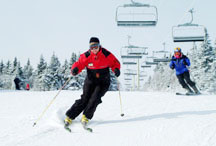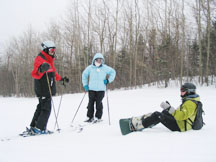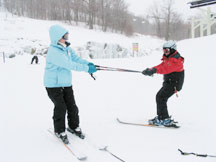Clinics help women master mountain sports
STRATTON, Vt. -- I stood at the top of the Villager ski run at Stratton Mountain, with my feet strapped to a snowboard, trying to gather my nerve. Having been a skier for 32 years, I felt strange standing sideways on just one board, without any poles for balance, preparing to slide down a hill in a duck stance.
 I won the snowboard earlier this season, but it had been propped
against a wall at home for months, occasionally serving as a
doorstop or dinner tray, until I finally decided it was time to
learn how to use it. My husband, a boarder for more than a decade,
offered to show me how to ride, but getting lessons from a friend or
relative can often add to the challenge.
I won the snowboard earlier this season, but it had been propped
against a wall at home for months, occasionally serving as a
doorstop or dinner tray, until I finally decided it was time to
learn how to use it. My husband, a boarder for more than a decade,
offered to show me how to ride, but getting lessons from a friend or
relative can often add to the challenge.
New England resorts offer clinics, camps, and workshops for women skiers and snowboarders of all abilities. I picked Stratton, since Burton -- the largest snowboard manufacturer, based in Burlington, Vt. -- created the world's first snowboard school here in 1984. Stratton is also one of only three ski resorts in North America that offer Burton's Women's Learn-to-Ride Program (the others are Copper Mountain in Colorado and Whistler/Blackcomb in British Columbia).
The snowboard boots are shaped to fit a woman's foot, and the two boards -- the Learn to Ride and Cruzer -- have a woman's cut and are designed to make it easier to turn. Beginners are less likely to catch an edge (the snowboarding and skiing equivalent of tripping and falling). "The boards are constructed in a way that cuts down on the 'ow!' falls," said Alexa Ragozin, my instructor.
The Burton program aims to "create efficient riders quickly," she
added. Classes have no more than four students per instructor, move
at a relaxed pace, and focus on the muscles and movements that are
closest to the board, so students accomplish the most in the
shortest time.
Classes have no more than four students per instructor, move
at a relaxed pace, and focus on the muscles and movements that are
closest to the board, so students accomplish the most in the
shortest time.
"The goal is to have fun, not come out of this feeling like you've just taken the SATs," said Ragozin.
I joined six other women for Stratton's Sisterhood Winter Rally, a three-day ski and snowboard clinic with lessons, video analysis, talks by industry pros on equipment and clothing, and a chance to demo new skis. We also had several fully catered meals, plus access to the Stratton Sports Center.
The women in our group included four skiers and two beginner snowboarders. We ranged in age from 18 to 67 (five out of seven were over 45), and we all had slightly different goals.
Several women were solid skiers who wanted to fine-tune their skills and shake bad habits. Others wanted to stick to the intermediate slopes and work on their parallel turns and confidence.
Lindsay Durr, 18, a
“I
used to be an intermediate skier, but I’m realizing that you just
don’t start up where you left off,” she said early on.
 I
took her advice and used the women’s LTR, a super-soft and
responsive board for the first day of the clinic.
As I rolled my feet beneath me to start a turn, the board
twisted and flexed, so I could feel when I’d done something right
and instantly know when I had miscalculated.
I
took her advice and used the women’s LTR, a super-soft and
responsive board for the first day of the clinic.
As I rolled my feet beneath me to start a turn, the board
twisted and flexed, so I could feel when I’d done something right
and instantly know when I had miscalculated.
I spent the first day learning about balance
and how to weight the board and make basic turns. By afternoon, I
had learned how to stay vertical and had improved enough to move
from the beginner’s area to easy intermediate.
Then
everything unraveled on day two. My legs were burning, my balance
was off, and I discovered I didn’t bounce as well as I used to.
That
morning, I had graduated to the Cruzer board, which had a slightly
different shape and sidecut, and was noticeably stiffer than the LTR,
but would help me make carved turns. Eventually, it did, but in the
meantime, I left dozens of body prints in the snow, as I pitched,
plunged and tumbled my way down the mountain. Ragozin
remained encouraging and patient while I learned the benefits of
wearing a helmet, kneepads and wrist guards, and vowed to buy padded
snowboarding pants the next chance I got.
The learning process is different for each person, but it often takes three days for everything to fall into place. The first day, you break down the components and focus on a particular skill. The second day, your muscles are tired and still struggling to memorize the new method. By the third day, you feel stronger and everything finally comes together.
We all improved significantly by day three and, most important, we were having fun.
Everything finally clicked for me, and I spent day three linking turns on intermediate trails and remaining on my feet most of the time. I jumped on my new snowboard and ended the day with a final run down an expert trail—something that had taken me years to accomplish on skis.
My snowboard is back home, propped up against a wall and showing a few hard-earned scratches, but it’s no longer simply a decoration or a doorstop.
Kari J. Bodnarchuk
is a freelance writer in Somerville.
If you go...
Where to learn